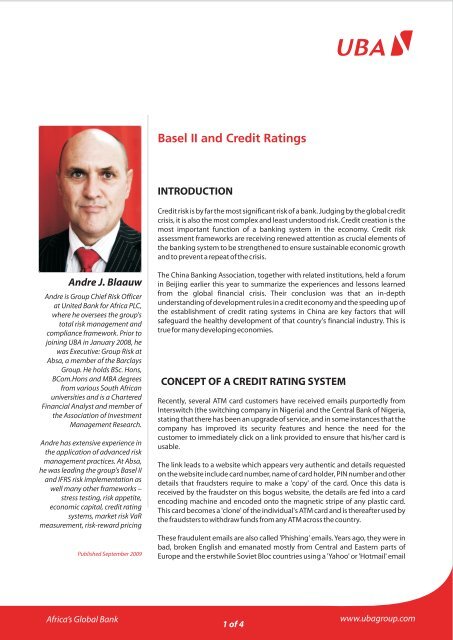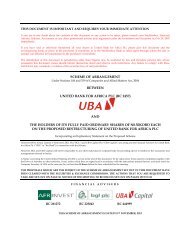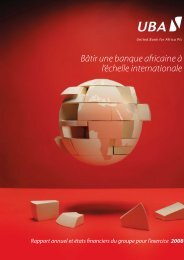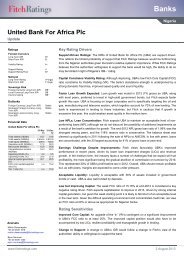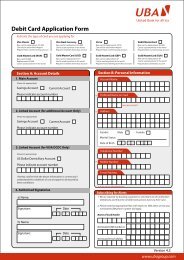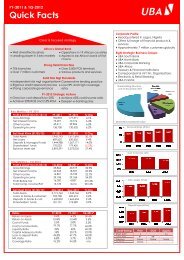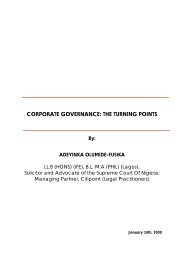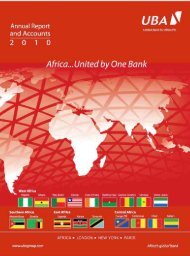Basel II and Credit Ratings - UBA Plc
Basel II and Credit Ratings - UBA Plc
Basel II and Credit Ratings - UBA Plc
Create successful ePaper yourself
Turn your PDF publications into a flip-book with our unique Google optimized e-Paper software.
<strong>Basel</strong> <strong>II</strong> <strong>and</strong> <strong>Credit</strong> <strong>Ratings</strong><br />
INTRODUCTION<br />
<strong>Credit</strong> risk is by far the most significant risk of a bank. Judging by the global credit<br />
crisis, it is also the most complex <strong>and</strong> least understood risk. <strong>Credit</strong> creation is the<br />
most important function of a banking system in the economy. <strong>Credit</strong> risk<br />
assessment frameworks are receiving renewed attention as crucial elements of<br />
the banking system to be strengthened to ensure sustainable economic growth<br />
<strong>and</strong> to prevent a repeat of the crisis.<br />
Andre J. Blaauw<br />
Andre is Group Chief Risk Officer<br />
at United Bank for Africa PLC,<br />
where he oversees the group's<br />
total risk management <strong>and</strong><br />
compliance framework. Prior to<br />
joining <strong>UBA</strong> in January 2008, he<br />
was Executive: Group Risk at<br />
Absa, a member of the Barclays<br />
Group. He holds BSc. Hons,<br />
BCom.Hons <strong>and</strong> MBA degrees<br />
from various South African<br />
universities <strong>and</strong> is a Chartered<br />
Financial Analyst <strong>and</strong> member of<br />
the Association of Investment<br />
Management Research.<br />
Andre has extensive experience in<br />
the application of advanced risk<br />
management practices. At Absa,<br />
he was leading the group's <strong>Basel</strong> <strong>II</strong><br />
<strong>and</strong> IFRS risk implementation as<br />
well many other frameworks –<br />
stress testing, risk appetite,<br />
economic capital, credit rating<br />
systems, market risk VaR<br />
measurement, risk-reward pricing<br />
Published September 2009<br />
The China Banking Association, together with related institutions, held a forum<br />
in Beijing earlier this year to summarize the experiences <strong>and</strong> lessons learned<br />
from the global financial crisis. Their conclusion was that an in-depth<br />
underst<strong>and</strong>ing of development rules in a credit economy <strong>and</strong> the speeding up of<br />
the establishment of credit rating systems in China are key factors that will<br />
safeguard the healthy development of that country's financial industry. This is<br />
true for many developing economies.<br />
CONCEPT OF A CREDIT RATING SYSTEM<br />
Recently, several ATM card customers have received emails purportedly from<br />
Interswitch (the switching company in Nigeria) <strong>and</strong> the Central Bank of Nigeria,<br />
stating that there has been an upgrade of service, <strong>and</strong> in some instances that the<br />
company has improved its security features <strong>and</strong> hence the need for the<br />
customer to immediately click on a link provided to ensure that his/her card is<br />
usable.<br />
The link leads to a website which appears very authentic <strong>and</strong> details requested<br />
on the website include card number, name of card holder, PIN number <strong>and</strong> other<br />
details that fraudsters require to make a 'copy' of the card. Once this data is<br />
received by the fraudster on this bogus website, the details are fed into a card<br />
encoding machine <strong>and</strong> encoded onto the magnetic stripe of any plastic card.<br />
This card becomes a 'clone' of the individual's ATM card <strong>and</strong> is thereafter used by<br />
the fraudsters to withdraw funds from any ATM across the country.<br />
These fraudulent emails are also called 'Phishing' emails. Years ago, they were in<br />
bad, broken English <strong>and</strong> emanated mostly from Central <strong>and</strong> Eastern parts of<br />
Europe <strong>and</strong> the erstwhile Soviet Bloc countries using a 'Yahoo' or 'Hotmail' email<br />
Africa’s Global Bank<br />
1 of 4<br />
www.ubagroup.com
<strong>Basel</strong> <strong>II</strong> <strong>and</strong> <strong>Credit</strong> <strong>Ratings</strong><br />
Andre J. Blaauw<br />
tools, etc. He was also a member<br />
of the Barclays Group Risk<br />
Technical committee, the<br />
oversight body in the Barclays<br />
group for all technical risk<br />
management frameworks<br />
implementation. During the 4<br />
years of <strong>Basel</strong> <strong>II</strong> implementation<br />
in South Africa he served as the<br />
chairman of the credit risk task<br />
identities. More recently, the fraudsters have become more sophisticated in<br />
creating authentic looking email IDs of the Central Bank of Nigeria <strong>and</strong><br />
Interswitch. They have also created websites that appear genuine to the ordinary<br />
consumer.<br />
Consumers must be aware that, BANKS AND CARD COMPANIES WOULD NEVER<br />
ASK FOR A CARDHOLDER'S PIN NUMBER <strong>and</strong> are therefore urged to call their<br />
bank on the BANK'S customer service line (not on the number provided on the<br />
fraudulent email!) <strong>and</strong> confirm the authenticity of the request. Consumers are<br />
advised to immediately delete such emails <strong>and</strong> advise friends to do the same.<br />
group of the accord<br />
implementation structure, lead by<br />
the SA central bank. Andre has<br />
been a regular presenter at<br />
conferences <strong>and</strong> international<br />
risk industry events. The World<br />
Bank invited him on two<br />
occasions to share his experience<br />
of <strong>Basel</strong> <strong>II</strong> implementation in<br />
South Africa with the central<br />
banks of other emerging markets<br />
at <strong>Basel</strong> <strong>II</strong> implementation<br />
planning events in Colombia <strong>and</strong><br />
Turkey.<br />
ASSET CLASSES<br />
B<strong>II</strong> recognises the fact that the characteristics driving credit risk differs by<br />
segment. Rating system requirements are therefore differentiated by the<br />
following asset classes: corporate exposures, specialised lending (project<br />
finance, etc.), sovereign exposure, public sector entities, bank exposures, other<br />
financial institutions, retail exposures, revolving exposures, purchased<br />
receivables, securitized assets, SME's, etc. Where risk behaviour differs within an<br />
asset class – e.g. salaried v self employed retail customers, further differentiation<br />
of the rating system is required so that the unique credit risk characteristics of<br />
each homogenous risk pool is adequately captured.<br />
Risk grading, default estimation <strong>and</strong> loss estimation models <strong>and</strong> methods must<br />
be implemented for each asset class/ homogenous risk pool. With the South<br />
African implementation of B<strong>II</strong>, banks typically had to implement 40-50 rating<br />
models to meet the requirements for accurate risk differentiation by rating<br />
systems.<br />
To execute its B<strong>II</strong> adoption, <strong>UBA</strong> has commenced with the design of a<br />
comprehensive rating systems architecture that will provide the key building<br />
blocks for ratings based decisions. This will enable scientific measurement <strong>and</strong><br />
management of credit risk in all the group's local <strong>and</strong> international customer<br />
segments.<br />
Africa’s Global Bank<br />
2 of 4<br />
www.ubagroup.com
<strong>Basel</strong> <strong>II</strong> <strong>and</strong> <strong>Credit</strong> <strong>Ratings</strong><br />
Andre J. Blaauw<br />
USE OF RATING SYSTEMS<br />
To meet the stringent requirements of the B<strong>II</strong> internal ratings based approach,<br />
banks must be able to demonstrate the use of credit ratings in key business<br />
decisions such as credit approvals, loan pricing, market segmentation, credit<br />
portfolio monitoring, provisioning, debt collections, capital allocation <strong>and</strong><br />
performance management. Merely using ratings as a credit assessment tool is<br />
not sufficient.<br />
Maintaining the integrity of rating system outputs is crucial given the many uses<br />
<strong>and</strong> key decisions which depends on credit risk. The B<strong>II</strong> framework recognises<br />
this fact <strong>and</strong> sets elaborate process requirements for ensuring the ongoing<br />
quality of rating systems outputs. These include:<br />
Independent credit control unit responsible for the design <strong>and</strong> maintenance<br />
of credit rating systems;<br />
Data history requirements to ensure rating models are taking a wide range of<br />
historical risk events into account;<br />
Rating model validation requirements, using back testing <strong>and</strong> other techniques<br />
to ensure model accuracy;<br />
Regular internal audit review of all aspects of rating systems;<br />
Ongoing training of the board <strong>and</strong> senior management on the internal workings<br />
of the bank's rating systems;<br />
Designated board committee tasked with approval, oversight <strong>and</strong> monitoring<br />
of rating systems effectiveness<br />
Disclosure of rating system results in published financial reporting, regulatory<br />
reporting, etc.<br />
Designing <strong>and</strong> implementing a credit rating system is a highly complex activity.<br />
Key challenges that banks have to overcome are:<br />
Lack of sufficient historical data<br />
Limited expertise <strong>and</strong> knowledge of rating methodologies<br />
Integrating ratings with bank IT systems<br />
Awareness, underst<strong>and</strong>ing <strong>and</strong> interpretation of credit ratings<br />
Timeously adapting rating systems to ever changing customer profiles,<br />
credit risk environment, business strategy changes, etc.<br />
<strong>Credit</strong> ratings development is therefore a journey. International banks have<br />
spent many years in developing <strong>and</strong> enhancing their credit rating systems <strong>and</strong><br />
are still continuing to do so.<br />
Africa’s Global Bank<br />
3 of 4<br />
www.ubagroup.com
<strong>Basel</strong> <strong>II</strong> <strong>and</strong> <strong>Credit</strong> <strong>Ratings</strong><br />
Andre J. Blaauw<br />
CURRENT STATE OF CREDIT RATING SYSTEMS IN NIGERIA<br />
<strong>Credit</strong> rating systems application in Nigeria is currently at an early stage of<br />
development. Consumer credit behaviour data is being pooled by credit<br />
bureau's that can be used in the design of retail credit rating models. External<br />
credit ratings assigned by credit rating agents for bank <strong>and</strong> multinational<br />
corporate names are available <strong>and</strong> are being used in the credit decision process<br />
by some banks. Few Nigerian banks have, however, attempted to develop loss<br />
<strong>and</strong> default estimates for their ratings as required by B<strong>II</strong>. Wider using of ratings<br />
outputs in business decisions is limited. Rating systems knowledge is very<br />
scarce.<br />
The CBN should take a lead role in credit ratings system implementation in the<br />
Nigerian banking system. These actions should include:<br />
setting requirements for m<strong>and</strong>atory default <strong>and</strong> loss data collection by banks<br />
setting st<strong>and</strong>ards for rating integrity assurance<br />
setting ratings information disclosure requirements<br />
setting requirements for the use of credit ratings in banks business decisions, etc<br />
Early adoption of B<strong>II</strong> implementation by the CBN will institutionalise these<br />
issues.<br />
CONCLUSION<br />
Every credit decision is a bet with shareholder's money. In the Nigerian<br />
environment, the odds of making a good bet is not very high, given the many<br />
uncertainties impacting the outcome of a credit decision <strong>and</strong> resulting credit<br />
losses. This will limit the development of credit growth in the economy. The B<strong>II</strong><br />
internal ratings based approach provides a rigorous framework for high quality<br />
credit rating systems which can provide a solid foundation for the development<br />
of a credit economy in Nigeria. The CBN should play a lead role <strong>and</strong> accelerate B<strong>II</strong><br />
implementation to institutionalise the application of credit rating systems in the<br />
banking system.<br />
Africa’s Global Bank<br />
4 of 4<br />
www.ubagroup.com


